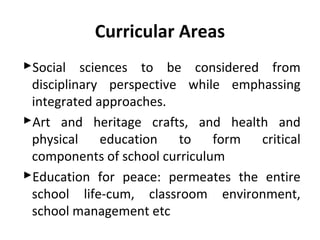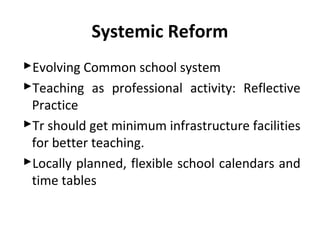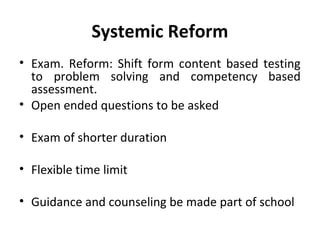National curriculum framework 2005
- 1. NATIONAL CURRICULUM FRAMEWORK NCF-2005 Dr Ramakanta Mohalik Faculty of Education Regional Institute of Education, BBSR
- 2. What is NCF It is a document seeks to provide a framework within which teachers and schools can choose and plan experiences that they think children should have. It address four issues such as educational purpose, educational experience, organization of experience and assessing learner.
- 3. What is NCF It differs from Curriculum and Syllabus. It is only suggestive and provides guidelines on different aspects of education NCF came in 1975, 1988, 2000 and 2005 Earlier NCFs were based Behaviorist psy but NCF 2005 based on Constructivist All the states also developed SCF in line with NCF
- 4. Why NCF NCF as means of evolving a National system of Education capable of responding to Indias diversity of geographical and cultural milieus while ensuring common core of values along with academic components To make school education comparable across the country in qualitative terms and also making it as means of ensuring national integration without compromising on the country's pluralistic character.
- 5. Why NCF 2005 To remove ills of present school education Inflexibility of school practice Learning becomes a isolated activity than life School discouraging creative thinking Neglecting whole personality of child Neglecting present of child for future
- 6. Development of NCF-2005 National Steering Committee was set up under chairman ship of Prof. Yash Pal and 21 national Focus groups National Focus groups are: Aims of edn, Teaching Eng, Teaching Sc/SS/Math, Ednal technology etc Finally discussed and passed in CABE on 7th Sept. 2005
- 7. Contents of NCF 2005 Perspective: guiding principles Learning and Knowledge: Curricular area: School and classroom: Systemic reform:
- 8. Perspectives Strengthening National system of edn Reducing curriculum load Curriculum as per constitutional values Quality edn for all
- 9. Guiding principles Connecting knowledge to life outside school Learning is shifted away from rote method Overall development of child NOT textbook centric Exam system more flexible and integrated with classroom life and Nurturing democratic polity of the country
- 10. Learning and Knowledge • Reorientation of our perception to learner and learning • Child centered pedagogy • Holistic approach to learners development • Adequate room for children thought, curiosity, and questions in teaching • Connecting knowledge across boundaries • Inclusive environment in class for all
- 11. Learning and Knowledge • Learners engagement: experience, making and doing, experimenting, reading, discussion, asking, listening, thinking and reflecting, expressing oneself. • Teaching for Construction of Knowledge: Learners actively construct their own knowledge by connecting new ideas to existing ideas on basis of materials/ activities presented to them.
- 12. Learning and Knowledge Construction indicates that learner individually/socially constructs meaning as her/she learns. It happens in collaboration, negotiation, sharing of views. Role of teacher is to facilitates, provide materials/ activities and coordinate. It can be done by allowing students to ask questions, answer in own words, intelligent guessing, asking students to ask question by listening answer.
- 13. Learning and Knowledge • Critical pedagogy: opportunity to reflect critically on issues in terms of their political, social, economic and moral aspects by open discussion and encouraging and recognizing multiple views. • Contextualization of teaching with children's and local knowledge.
- 14. Curricular Areas • Implementation of three language formula: Multilingual education. • Teaching math is to develop thinking and reasoning, to visualizing abstractions and formulate and solve problems. • Teaching of science is to enable learner to acquire method and process that will nurture thinking process, curiosity and creativity.
- 15. Curricular Areas Social sciences to be considered from disciplinary perspective while emphassing integrated approaches. Art and heritage crafts, and health and physical education to form critical components of school curriculum Education for peace: permeates the entire school life-cum, classroom environment, school management etc
- 16. Curricular Areas • Assessment: Integral part of the learning process and benefits both learner and teacher by giving credible feedback. • Purpose is to enhance quality of teaching and learning. • Assessment is to be continuous and internal/school based.
- 17. School and Classroom Environment School environment: colorful, friendly and peaceful, with lots of open space offering with animals, plants, flowers, trees and toys. Class size: Not higher than 1:30 Democratic classroom practice Participation of Community members Participation of all learners in class work Policy of inclusion to be followed
- 18. School and Classroom Environment • Text books: Carefully written and designed, professionally edited and tested, offering not merely factual information but interactive space for children. • Writer focus on elaboration of concepts, activities, spaces for wondering about problems, exercise encouraging thinking and small group work. • Thinking for Multiple text book
- 19. Systemic Reform Evolving Common school system Teaching as professional activity: Reflective Practice Tr should get minimum infrastructure facilities for better teaching. Locally planned, flexible school calendars and time tables
- 20. Systemic Reform • Encouraging community participation for enhancing quality and accountability in teacher:PRI • Academic leadership of Principals is related to performance school • In service edn of teacher can not be Event but Process- which includes knowledge development and change in attitudes, skills and practice- through interaction both in workshop setting and in the school.
- 21. Systemic Reform • Exam. Reform: Shift form content based testing to problem solving and competency based assessment. • Open ended questions to be asked • Exam of shorter duration • Flexible time limit • Guidance and counseling be made part of school
- 22. THANK YOU






















